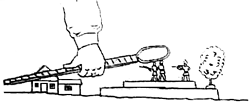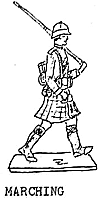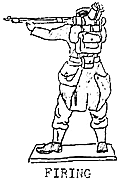 This is where I came in!
This is where I came in!
The first piece of wargaming literature I ever purchased was Jack Scruby's All about War Games. It's sitting here in front of me now. I can't remember how I found out about it, but it was in Jan. 1967, 10 years after its publication date, and my first look at the "professional" side of wargaming.
A 23 page mimeographed piece, complete with the typos and misspellings endemic with that old format, All about War Gaming filled a gap left open by Bob Bard's model soldier publications. It covered a bit of the same ground, but it also included enough explicit rules so that a reader could get out a couple of armies and play. The rules were pretty basic, as we'll see, but the fundamentals were there and, in conjunction with Scruby's quarterly "War Game Digest," a gamer could keep up with the ideas in the forefront of the hobby. Of course, with 40 subscribers, the "Old Guard," as they came to be known, "War Game Digest" was a mere hint of things to come and All about War Games helped move that process along.
As ephemeral as this booklet may appear, it's important to note that it is nearly the first stand alone piece to come out since Shambattle. The only exceptions I'm aware of are another mimeographed title from 1952, Fred L. Patlel's "Krieg-Spiel," and Fletcher Pratt's naval rules. I'll discuss the latter in a future article. It would be five more years before more substantial wargaming books would be published. Certainly for me, since there is real publishing continuity from this point forward, 1957 is the beginning of wargaming as a hobby separate from the collector's realm, and, as Bob Beattie calls it, the beginning of the Second Age of Wargaming.
1957 didn't just see the publication of All about War Gaming and the beginning of "War Game Digest," but also the opening of Scruby Miniatures, his wargame figures manufacturing business. Scruby had created a way to use LTV rubber to make molds that lasted longer and allowed him to produce figures in much greater quantity and variety than previously possible. Since he was targeting wargamers, rather than collectors, Scruby began with 30mm figures. Coincidentally, SAE also introduced painted 30mm figures around this time, so the new "war gaming scale" was doubly represented and off to a good start. These two were soon followed by Staden, Suren Command and JAL, which further cemented 30mm's place as the scale for the hobby.
Like many wargamers of his era whom I've spoken with, Scruby began his gaming with the then ubiquitous 54mm models and made his first contacts with other gamers at collector's events. As we saw in the last installment (Herald #39), the collector's societies provided a focus point for gamers, and Scruby was able to use them to begin a network in the United States and Britain. A man with a vision, he was able to draw many of these people together and provide them with the tools to move forward with their hobby. We've seen how he helped provide a new figure scale which permitted the use of greater numbers of models on the wargaming table and also a much greater variety of figures. This enabled gamers to spend more time on the battlefield, rather than converting models to create troop types otherwise unavailable.
Scruby also recognized the need of wargamers to communicate with each other, and, since this series is interested in the publishing history of wargaming, let's get back to his efforts there. Since I don't have "War Game Digest" in my collection, I can only relate Bob Beattie's description of it. (Beattie's Courier article is the basis for much of the background information in this piece.) Scruby started "War Game Digest" as a way to simplify the ongoing correspondence among the collection of wargamers he'd gathered together over the years. Right out of the gate, "War Game Digest" began spreading new ideas throughout the hard core gaming community. Specialized troops -- light troops, grenadiers and sappers, for example -- were introduced. Movement trays were also brought into play, though combat remained between individual soldiers. Historical periods began to be represented more specifically, too, with rules appearing for ancient, medieval and modern warfare, in distinction to the previous, generally undifferentiated rule sets. Morale effects were discussed and used on the tabletop. Written orders, which allowed simultaneous movement, showed up in these articles, adding another exciting variant to the growing panoply of wargaming possibilities. While some of these ideas had popped up before, this was the first time there was an organized public discussion of them on this scale. The ongoing conversation allowed the hobby to advance much more quickly from this point on.
While the Old Guard were discussing the current state and setting the future direction of wargaming in "War Game Digest," All about War Gaming provided a starting point for people new to the hobby. In 1967, that was me. All about War Gaming surveys the world of our hobby, looking at building armies, painting figures, table sizes, and, not least, provides a basic set of rules that a new wargamer could use to get his model soldiers into battle. Scruby provides a very brief introduction, noting that "War Game Digest" was a bit complex for the novice, while Wells' Little Wars, the main alternative introduction, was too simple for most people's needs. After recommending Bob Bard's book as a place to learn more about the history of model soldiers and wargaming, and reminding the reader of his "vested interest" in wargaming, as both publisher and manufacturer, he provides a basic glossary of wargaming terms.

The following two chapters quickly review the various options available for figures, conversion and painting. Noting that "most war game generals attempt to be as realistic about their play as historically possible," he describes how rules might differ among the three main subdivisions of Ancient, Musket and Modern wargames. He goes on to describe the various sizes and shapes (flat and round) of the figures available, briefly looks at conversion of figures, once again directing readers to Bob Bard's book, and then describes some painting techniques. There are a couple of interesting items in the painting section. He suggests using different types of paint, which won't mix together when applied in successive coats. Thus oil and water based paints can avoid the bleeding situation we often find ourselves in, especially if, like me, you can't wait for one color to dry completely before moving on to another. His other suggestion is one that I immediately adopted. He called it a "sloppy undercoat, careful overcoat" method. He would slop on the first color, not worrying about "staying within the lines." Following coats would also be slopped on, except where the new color met one of the old ones, where a neat line was made. I find that I'm particularly good at the "sloppy undercoat" part.
With Chapter 4 we find ourselves moving out of anything related to collecting and preparing miniature figures, and into wargaming proper. If one is going to game, a space for it is a necessary precondition, so Scruby's next topic is "The War Game Setup," covering space needs, tables and terrain. Once again, the discussion is brief, but long enough to have made me pine for a "sand" table for over 30 years.
The following chapter, "Organization of Your War Game Armies," suggests regiments of 30 men, with 10 to a company. Since many of the rules in use had volley groups of six, 10 men to a company provided for some casualties before fire power was reduced. Scruby suggests painting in batches of 15, a less imposing task than taking on a full regiment, but still allowing for two volley groups and a few casualties. Regiments could be identified by distinctive colors, but also by having all their members in distinctive positions, an arrangement enhanced by the greater variety of figures becoming available. For a musket period battle fought with 30mm models on a 4' by 8' table, he suggests that a complete army, with 9 regiments, light infantry, cavalry and artillery, would have 192 soldiers. When you recall that these were still individually based, that's quite a handful. On an "ideal" 6' by 12' table, Scruby would have armies of 300 figures on each side.
After collecting a couple of armies together, getting them painted, organized and providing a place to play with them, we're ready to start gaming -- once we've prepared some rules of play.
The rules we've looked at in earlier articles are all pretty basic, though we've also seen continuing interest in building on them to create greater realism. Scruby offers a core set of rules in All about War Gaming while encouraging experimentation. Actually, one might describe the booklet's rule section as a cafeteria style set since, in most sections, it offers choices for the gamer to choose among. Right out of the gate, we're given alternatives, rather than hard and fast directives, as he describes several types of gaming systems. These include The Alternative Move Game, where each player moves and fires all his troops in turn; The Combination Game, in which movement alternates, but combat is simultaneous; The Simultaneous Game, which has players moving at the same time, each beginning from their left, then simultaneous combat; The Move-Countermove Game, where dice rolls give one of the players the right to decide whether to move first or second, with combat decided simultaneously after both sides finish movement. Other than card based impulse systems, this seems to cover the main gaming options I've encountered.
Moving on to the specifics, Scruby discusses movement and ranges of fire. Here he provides some useful rules of thumb. Cavalry normally moves twice as far as infantry, musket fire range is equivalent to a cavalry move (rifles somewhat longer), and artillery range is 4 to 5 times an infantry move. When combat occurs it is more important that the sequence of small arms fire, melee and artillery fire be consistent than in any particular order.
When it comes to melee combat, Scruby demonstrates that no rule is so good that it cannot be "improved" upon. After noting that he can think of at least eight different melee systems, he goes on to praise Captain Sachs' version as good for beginners, then immediately suggests variations to carry it further towards a more realistic format, and to adapt it for different periods. He ends with Homer Delabar's system which gives infantry 1 point and cavalry 2 points, adds a die roll for a random factor, and then uses a percentage based formula to determine the casualties for the winning and losing sides. Quite a step forward from the simpler, but bloody Wellsian format.

As indicated above, fire was by volley groups of six, reflecting the standard die. As an alternative, fire tables could be made up which automatically assigned casualties for a particular number and type of soldier.
Morale played an important role in Scruby's basic rule collection. The are suggestions for both pre- and post-combat morale tests. Morale tests and results were useful in avoiding static lines, with the two sides blazing away at each other until only one figure was left standing.
After describing rule ideas for artillery and specialized troop types, Scruby goes on to promote solo wargaming as a good option when no opponents are available. This was a suggestion I took to heart, fighting a number of American Civil War campaigns and many World War I and II battles on a basement tabletop. For a more complete look at rules ‡ la Scruby, take a look at my article in The Herald #26. This describes a 19th century colonial rule set that reflects many of the ideas presented in this booklet.
All about War Games penultimate chapter, "Paper Work," provides a number of suggestions to enhance the war game experience off the table. Scruby uses Robert Louis Stevenson's propagandist battle reports as good examples of what's possible here. Preparation of game maps and scenarios ahead of time allows all the participants a chance to think about their possible tactics. Placing the game in a campaign context gives them a greater reality, even if it is in a fantasy situation. Campaigns can be fought in the even broader context of a war, all of which lends itself to after action reports and histories.
Scruby ends his work with an acknowledgment that most of the "Basic Rules" he's just described were not original, but picked up from the broader wargame community. He lists a number of these innovators and, I suspect, you'd still recognize many of them.
This brief booklet provided the beginning gamer in the late 50's and early 60's with a toolbox to get started with miniature based wargaming. It still gives an interesting view of the level of development reached by that point, and brings back many fond memories of youthful days and nights at the gaming table.
References:
Beattie, Bob. "Jack Scruby : The Father of Modern Wargaming." The Courier, vol. 1, no. 3, March-April 1980. Reprinted in MagWeb, http://www.magweb.com/premium/courier/v1n5/tc15scru.htm
Frank, Dennis. "Jack Scruby's Colonial Rules." The Herald, 26, Nov./Dec. 1998. 15-20.
Scruby, Jack. All About War Games. Visalia, Jack Scruby Military Miniatures, 1957
More Roots of Wargaming
-
Robert Louis Stevenson
H.G. Wells
Shambattle
Children and Toy Soldiers
Links Between Military Miniature Collecting and Gaming
Jack Scruby
1962
Table Top Talk Magazine
Naval Wargames Part 1
Naval Wargames Part 2
Air Wargames
Horse and Musket I
Napoleon Rides Again
Featherstone Again
Back to The Herald 40 Table of Contents
Back to The Herald List of Issues
Back to MagWeb Master Magazine List
© Copyright 2001 by HMGS-GL.
This article appears in MagWeb (Magazine Web) on the Internet World Wide Web. Other military history articles and gaming articles are available at http://www.magweb.com